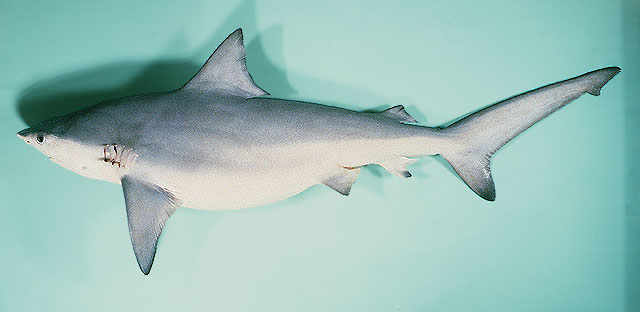| Carcharhinidae (Requiem sharks) |
| 280 cm TL (male/unsexed) |
|
reef-associated; brackish; marine; depth range 0 - 150 m |
| Eastern Atlantic: Nigeria. Indo-West Pacific: Persian Gulf (Ref. 68964), Gulf of Aden, South Africa, Madagascar, Pakistan, Sri Lanka, Indonesia, Papua New Guinea (Ref. 6871), and Australia. Also reported from the Mediterranean (Ref. 83386). Often confused with sympatric Carcharhinus leucas and Glyphis gangeticus but the three are distinguishable. |
|
Dorsal spines (total): 0-0; Dorsal soft rays (total): 0-0; Anal spines: 0-0; Anal soft rays: 0-0. A massive shark with a thick-set head, a short, broad and blunt snout, small eyes and large, triangular, saw-edged upper teeth; 1st dorsal fin high and erect, at leas 3.2 times height of 2nd dorsal fin; no interdorsal ridge (Ref. 5578). Grayish in color, white below; fins with dusky tips (Ref. 5578). |
| An inshore species of the continental and insular shelves, commonly inhabiting shallow waters close inshore, near the surf line and along beaches (Ref. 244). It also occasionally enters brackish water (Ref. 127434), and may be found in shallow bays and estuaries, as well as off the open coast but not ascending rivers (Ref. 9997). Predominantly demersal but found throughout the water column (Ref. 6871). Feeds on pelagic and demersal bony fishes, sharks and rays, squid, shrimps, cuttlefish, octopi, lobsters, gastropods and mammalian carrion (Ref. 5578, 9997). Viviparous (Ref. 50449). Potentially dangerous but not recorded in shark attacks to date (Ref. 9997). Utilized fresh and dried-salted for human consumption (Ref. 9997). |
|
Vulnerable (VU); Date assessed: 29 October 2020 (A2d) Ref. (130435)
|
| traumatogenic |
Source and more info: www.fishbase.org. For personal, classroom, and other internal use only. Not for publication.

